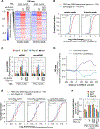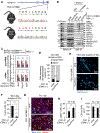PGC-1α senses the CBC of pre-mRNA to dictate the fate of promoter-proximally paused RNAPII
- PMID: 36669479
- PMCID: PMC9951270
- DOI: 10.1016/j.molcel.2022.12.022
PGC-1α senses the CBC of pre-mRNA to dictate the fate of promoter-proximally paused RNAPII
Abstract
PGC-1α is well established as a metazoan transcriptional coactivator of cellular adaptation in response to stress. However, the mechanisms by which PGC-1α activates gene transcription are incompletely understood. Here, we report that PGC-1α serves as a scaffold protein that physically and functionally connects the DNA-binding protein estrogen-related receptor α (ERRα), cap-binding protein 80 (CBP80), and Mediator to overcome promoter-proximal pausing of RNAPII and transcriptionally activate stress-response genes. We show that PGC-1α promotes pausing release in a two-arm mechanism (1) by recruiting the positive transcription elongation factor b (P-TEFb) and (2) by outcompeting the premature transcription termination complex Integrator. Using mice homozygous for five amino acid changes in the CBP80-binding motif (CBM) of PGC-1α that destroy CBM function, we show that efficient differentiation of primary myoblasts to myofibers and timely skeletal muscle regeneration after injury require PGC-1α binding to CBP80. Our findings reveal how PGC-1α activates stress-response gene transcription in a previously unanticipated pre-mRNA quality-control pathway.
Keywords: CBP80; ERRα; Integrator; Mediator; P-TEFb; PGC-1α; cap-binding complex; gene transcription; interferon signaling; myogenesis; pre-mRNP quality control; promoter-proximal pausing; skeletal muscle regeneration.
Copyright © 2022 Elsevier Inc. All rights reserved.
Conflict of interest statement
Declaration of interests K.A. is a member of the Advisory Board of Molecular Cell.
Figures






References
-
- Cho H, Rambout X, Gleghorn ML, Nguyen PQT, Phipps CR, Miyoshi K, Myers JR, Kataoka N, Fasan R, and Maquat LE (2018). Transcriptional coactivator PGC-1alpha contains a novel CBP80-binding motif that orchestrates efficient target gene expression. Genes Dev. 32, 555–567. 10.1101/gad.309773.117. - DOI - PMC - PubMed
MeSH terms
Substances
Grants and funding
LinkOut - more resources
Full Text Sources
Molecular Biology Databases
Miscellaneous

